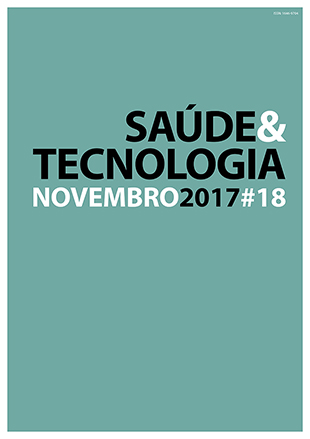Influence of the color scale in qualitative assessment of brain perfusion imaging
DOI:
https://doi.org/10.25758/set.2081Keywords:
Brain perfusion imaging, Color scale, Visual analysis, Qualitative assessmentAbstract
Introduction – Brain perfusion imaging (BPI) is an imaging study that allows the acquisition of three-dimensional tomographic images of the biodistribution of a tracer, reflecting regional brain perfusion. Therefore, the color scale used has a major role in the clinical interpretation of these images. Aim – To study the influence of the color scales in qualitative evaluation of the BPI and to conclude which are the most appropriate scales for the visual analysis. Methods – Thirty-one BPI studies were visually analyzed by 15 operators divided into two classes: operators without professional experience (10) and operators with professional experience (5) using the Cool, Gray, Gray Invert, Thermal, and Perfusion color scales. For the Cool color scale, the image analysis was performed through a semiquantitative score system. The remaining color scales were evaluated by comparison with the analysis of the images performed with the Cool color scale. Non-parametric Friedman Test was used to assess the interoperator variability (relative to the Cool color scale). The results obtained with the remaining color scales were evaluated according to the percentage of symbols the participants assigned during their visual analysis of the 31 studies. Results – Inter-operator variability has shown statistically significant differences among all participants (p<0.05). The results for the Perfusion color scale were the closest to the brain perfusion with Cool, and so is an alternative color scale for evaluation of brain perfusion images. Regarding Gray, Gray Invert, and Thermal color scales, their results were divergent, and thus should not be considered optimal for brain perfusion interpretation. Conclusion – The color scale selected can influence the qualitative assessment of BPI. Perfusion can be implemented in clinical practice as an alternative color scale for the analysis of BPI studies. Gray, Gray Invert, and Thermal color scales should not be considered optimal for brain perfusion interpretation.
Downloads
References
Catafau AM. Brain SPECT in clinical practice. Part I: perfusion. J Nucl Med. 2001;42(2):259-71.
Juni JE, Waxman AD, Devous MD Sr, Tikofsky RS, Ichise M, Van Heertum RL, et al. Procedure guideline for brain perfusion SPECT using (99m)Tc radiopharmaceuticals 3.0. J Nucl Med Technol. 2009;37(3):191-5.
Kapucu OL, Nobili F, Varrone A, Booij J, Vander Borght T, Någren K, et al. EANM procedure guideline for brain perfusion SPECT using 99mTc-labelled radiopharmaceuticals, version 2. EANM procedure guideline for brain perfusion SPECT using 99mTc-labelled radiopharmaceuticals, version 2. Eur J Nucl Med Mol Imaging. 2009;36(12):2093-102.
Juni JE, Waxman AD, Devous MD, Tikofsky RS, Ichise M, Van Heertum RL, et al. Society of nuclear medicine procedure guideline for brain perfusion single photon emission computed tomography (SPECT) using Tc-99m radiopharmaceuticals: version 2.0, approved February 7, 1999 [Internet]. Virginia College; 2002. Available from: https://www.coursehero.com/file/27154987/BRAIN-IMAGINGpdf/
Figueiredo A, Ramos E, Carolino E, Vaz TF, Vieira L. Influência da escala de cores na avaliação qualitativa das imagens de cintigrafia de perfusão do miocárdio [Influence of the color scale in qualitative assessment of myocardial perfusion imaging]. Saúde Tecnol. 2016;(15):19-27. Portuguese
Fortin MF. O processo de investigação: da concepção à realização. 5ª ed. Loures: Lusociência; 2009. ISBN 9789728383107
Velosa SF, Pestana DD. Introdução à probabilidade e à estatística. 3ª ed. Lisboa: Fundação Calouste Gulbenkian; 2008. ISBN 9789723111507
Candell-Riera J, Santana-Boado C, Bermejo B, Armadans L, Castell J, Casáns I, et al. Interhospital observer agreement in interpretation of exercise myocardial Tc-99m tetrofosmin SPECT studies. J Nucl Cardiol. 2001;8(1):49-57.
Lança CC, Reis C, Lança L. Perceção visual na avaliação diagnóstica em mamografia: uma revisão sistemática [Visual perception and diagnostic evaluation in mammography: a systematic review]. Saúde Tecnol. 2012;(T1):31-40. Portuguese.
Cleveland WS, McGill R. A color-caused optical illusion on a statistical graph. Am Stat. 1983;37(2):101-5.
Tedford WH Jr, Bergquist SL, Flynn WE. The size-color illusion. J Gen Psychol. 1977;97(1st Half):145-9.
Silva S, Santos BS, Madeira J. Using color in visualization: a survey. Comput Graph. 2011;35(2):320-33.
Downloads
Published
Issue
Section
License
Copyright (c) 2022 Saúde e Tecnologia

This work is licensed under a Creative Commons Attribution-NonCommercial-NoDerivatives 4.0 International License.
The journal Saúde & Tecnologia offers immediate free access to its content, following the principle that making scientific knowledge available to the public free of charge provides greater worldwide democratization of knowledge.
The journal Saúde & Tecnologia does not charge authors any submission or article processing charges (APC).
All content is licensed under a Creative Commons CC-BY-NC-ND license. Authors have the right to: reproduce their work in physical or digital form for personal, professional, or teaching use, but not for commercial use (including the sale of the right to access the article); deposit on their website, that of their institution or in a repository an exact copy in electronic format of the article published by Saúde & Tecnologia, provided that reference is made to its publication in Saúde & Tecnologia and its content (including symbols identifying the journal) is not altered; publish in a book of which they are authors or editors the total or partial content of the manuscript, provided that reference is made to its publication in Saúde & Tecnologia.







